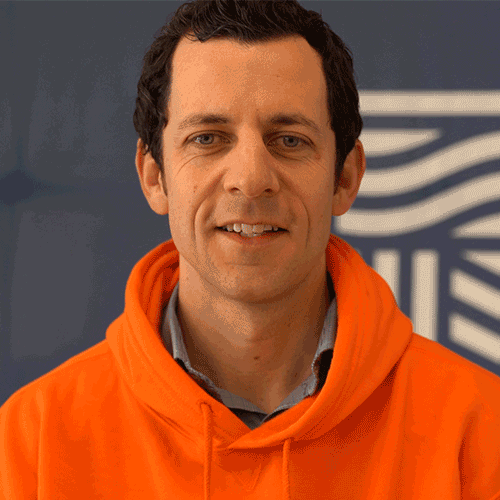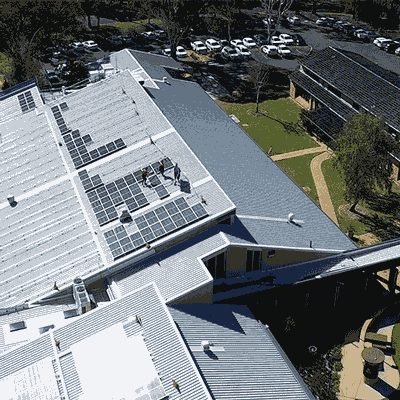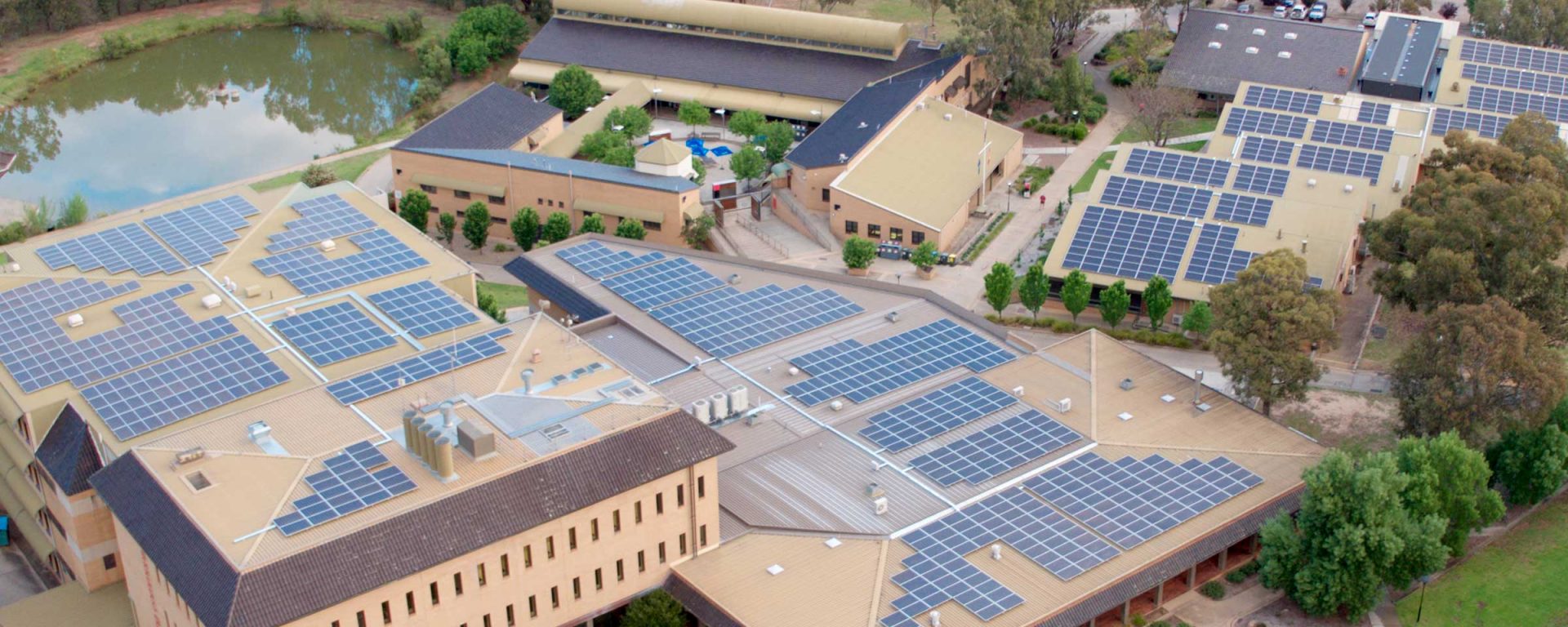At Charles Sturt University we’re stepping up and making practical progress with a range of green initiatives. In fact, we’re the #4 uni in Australia – and in the top 10 per cent of universities worldwide – for climate action in 2021.* So Ed Maher, our sustainability manager, knows a thing or two about renewable energy sources in Australia.

We asked Ed to check the state of play with renewable energy – like solar power. Can renewable energy help make a dent in our greenhouse gas emissions? Is solar energy a viable option for Aussie businesses and families? What’s stopping us from ramping up these energy options and charging into a sustainable future?
Does Australia still have a problem with greenhouse gases?
First things first. Are greenhouse gas emissions still a concern? Yes! We still find ourselves smack-bang in the middle of a global challenge! One where all nations need to do their bit to put us on track for a better future. And, Ed explains, countries like ours, the USA and Canada have the most work to do.
“Australia is one of the largest producers of greenhouse gas emissions in the world, when you look at it on a per capita basis. When you exclude some countries in the Middle East – which are very large exporters of fossil fuels and have relatively small populations – Australia really stands out. We measure with the Unites States and Canada as having the largest greenhouse gas intensity per capita.
“And from an environmental standpoint, that’s just not a good place to be. The impacts of human-produced greenhouse gas emissions on climate, changes to weather patterns, and the systems that we rely on as a species on this planet are heavy.”
So what’s the solution? More renewable energy sources!
For a sustainable future, Ed explains we need to rely less on fossil fuel energy sources and move toward more renewable energy sources, like solar power.
“Despite the fact that we’ve had a good uptake of renewable energy over the last decade or so, our energy market is still predominantly made up from fossil fuel sources. So, there’s plenty of room for improvement.”
“And when you look at where emissions come from, electricity generation jumps out as the largest contributor by quite a margin.
Some of the latest data produced by the Australian Government indicates that around 33 per cent of greenhouse gas emissions we produce comes from electricity production.”
“Look at where our biggest opportunity lies. Where we can have the most impact on mitigating our emissions. Electricity production is an obvious choice.”
So, to get the biggest bang for our buck we need to reduce emissions associated with electricity production – and that means phasing out fossil fuel derived sources. Can we do it?
Renewable energy sources: investing in our future
Ed explains that if we built new energy generation, the cost per hour of electricity would be cheaper if renewable sources were used!
“That’s why new and proposed renewable energy like solar is being adopted. Not just in Australia, but on an international scale as well. There have been very few new coal generation assets built in the last 15–20 years. And that works against the investment in coal generation.
“The transition from fossil fuels to renewable is inevitable. Most of Australia’s large energy generators are actively looking at how to address future energy supply. They know we have a large number of coal-fired generation assets due to be decommissioned over the next 15 years or so.”
Add to that the fact that renewable energy technology typically has a lower cost to construct and operate. Plus, there’s the uncertainty around regulations and the how the future pricing of carbon might look. The result?
“There’s a reluctance, across the globe, for investors to direct capital towards coal generation assets. From a financial perspective there’s an appetite to pursue renewables over fossil fuelled generation. The other reason to look at the electricity sector is because there are practical solutions that exist, technically and commercially right now.”

A win-win for households
So investors and big business look to be getting on board with renewable energy like solar power. What about your average householders? Should they light up over options like solar power?
“Over the last decade we’ve seen energy account for an increasingly large proportion of the household budget. Energy prices have increased quite dramatically. That means reducing the amount of energy that householders purchase from the grid will offer cost saving opportunities.
“So solar is a win-win for many households. Rooftop solar provides a sound investment over a reasonable time period. Household solar systems are, typically speaking, offering people a pay-back period of seven years or better.”
Roadblocks for renewable energy sources
So what’s stopping Australia from ramping up and using more renewable energy sources like solar energy? History and equity.
“We have the legacy of a generation system that’s historically made up of very large, centralised, predominantly coal-generated assets. They’re mainly located across eastern Australia – close to coal sources.
When you think about that, you realise it poses a challenge in terms of the poles and wires that support that setup. We haven’t historically had poles and wires running through inland Australia. But that’s where there’s opportunities for very cost-effective renewable energy generation.”
“Things are shifting now. We’re moving towards a greater amount of decentralised generation. We’re talking about possibly hundreds of utility-scale power stations spread across the country. Going further inland where we have access to marginal land that’s not great for agriculture or for other sources of income to support regional communities.
“We just have to figure out as a nation, how to overcome some of the technology challenges that exist. How will we transform our electricity network to take advantage of all the new technology – like solar – but do it in a commercially viable way? Thankfully, those discussions are starting to happen.”

A renewable future*
- Australia can be one of the fastest developed nations to transition its energy sector to renewables.
- By 2040 we could be using 94 per cent renewable energy.
*Australian Energy Market Operator
Making renewable energy sources in Australia affordable
And the issue of equity?
“There’s a potential equity issue. At the moment we’re still looking at a significant out-of-pocket, upfront cost to set up solar rooftop systems. That means those who most need relief from power bills are unable to consider solar. It’s financially out of reach for them. And many people may not own the house they’re living in, so how do they get access to solar energy?
At a national level we have a social responsibility to make sound decisions around energy policy. Ensure that we’re doing everything possible to make energy affordable in this country.”
“In the long term, the way to make energy affordable is to decouple ourselves from fossil fuels. Move away from the costs associated with pulling those resources from the ground and converting them into electricity. Instead, take full advantage of our abundant, free energy sources. And be conscious of incentives that will enable lower income households to have access to these systems as well.”
Agents of change at Charles Sturt
At Charles Sturt we’re stepping up and making practical progress with a range of green initiatives.
“We want to be good stewards of our environment and regional communities. That means getting things right in our own backyard. We’re looking to eliminate carbon emissions – at the source – for those fuels we use on our campuses.
“And we also want to model that behaviour. Because the real potential exists when we get our grads to be knowledgeable and skilled in these practices, so that when they become leaders and make decisions we will see a multiplying effect across the globe.”
Charles Sturt sustainable snapshot
- We’re the first certified carbon neutral university in Australia.
- We’re working towards a 2030 Clean Energy Strategy.
- We’ve installed nearly 16,000 solar panels installed across our regional campuses.
- Sustainable practice as a subject is integrated into all our undergraduate degrees.
- Our carbon offset program supports regeneration and renewable energy projects around the world.
Play your part
Want to overcome environmental challenges? Help ecosystems and communities grow and flourish? Learn more about our environmental science courses and let’s get to work!
*THE Impact Rankings 2021.


You must be logged in to post a comment.